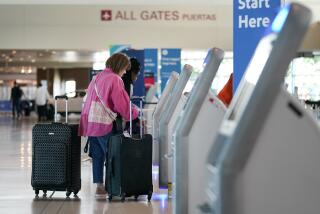In Test, Some U.S. Airline Pilots May Carry Guns as Early as April
- Share via
WASHINGTON — Starting this spring, U.S. airline pilots could be armed with Smith & Wesson .40-caliber semiautomatic guns, federal and pilots union officials said Wednesday.
The Transportation Security Administration and pilots groups are putting the finishing touches on a plan to train the first 48 “federal flight deck officers” and place them on flights as early as April or May.
As with federal air marshals, passengers will not know whether they are flying with a pilot who has volunteered to carry a gun on the job.
James M. Loy, the director of the TSA, called the program a “prototype” that could be expanded depending on how it works out, and on how much money Congress is willing to approve for training.
Training and equipping the first group of 48 will cost more than $10,400 per pilot, including purchasing the weapons.
President Bush has asked for $20 million to train pilot volunteers in the fiscal year beginning Oct. 1 and another $5 million for self-defense training for flight attendants.
“This is a modest beginning, but we hope that the program will prove itself and be expanded quickly,” said Henry Gasque, a spokesman for the Air Line Pilots Assn.
Thousands of airline pilots have indicated an interest in being trained to carry guns in the cabin.
The Bush administration was originally opposed to arming pilots, but had to accept the idea after Congress voted overwhelmingly in favor. Airlines, worried about liability, continue to have misgivings.
Under the plan, a pilot could only fire his or her weapon if an intruder breaks into the cockpit. Pilots would not be allowed to leave the flight deck to deal with incidents in the cabin, no matter how dire, because of the potential that they could be disarmed.
“It’s only if the guy is coming through the door,” said Robert Johnson, a spokesman for the TSA.
The armed pilots would have to submit to background checks and undergo psychological screening beyond what the government already requires for a pilot’s license.
They would report to a federal law enforcement training center -- there are three such facilities around the country -- for 48 hours of basic training that would include target practice and tactical drills. Upon graduation, they would be allowed to carry a gun while on the job.
“I am very concerned that we do [the training] right,” Loy told a Senate committee at a hearing earlier this month. “At the end of the day, I’m the guy that’s going to have to deputize these [pilots] to put a gun in their hands and do the right thing on an airplane at 30,000 feet.”
Armed pilot volunteers are expected to be discreet.
Their standard-issue semiautomatics -- a model popular with police agencies -- are to be carried inside a nondescript bag, locked and holstered. The gun could only be taken out inside the cockpit and by a deputized pilot. Showing the weapon to flight attendants or passengers would be treated as a serious violation and could result in removal from the program.
Armed pilots would serve as a last line of defense in the event of an attack on the cockpit.
They would also increase the armed presence on U.S.-based commercial airliners.
Several thousand federal air marshals now flying incognito can only cover a small proportion of the daily airline flights in the country.
Air marshals and armed pilots would be aware of one another’s presence on any given flight, to avoid potentially deadly misunderstandings.
Final details of the plan for arming pilots are expected to be released Tuesday.
More to Read
Inside the business of entertainment
The Wide Shot brings you news, analysis and insights on everything from streaming wars to production — and what it all means for the future.
You may occasionally receive promotional content from the Los Angeles Times.









